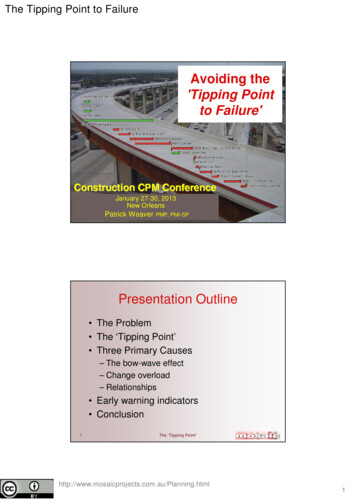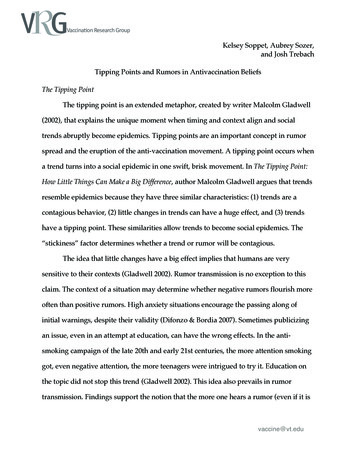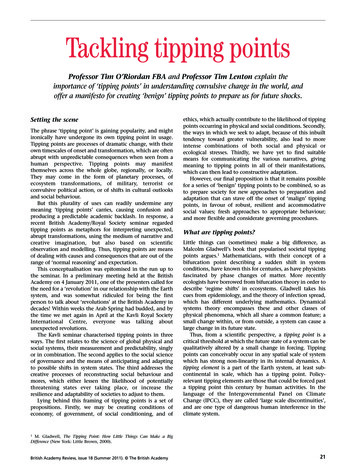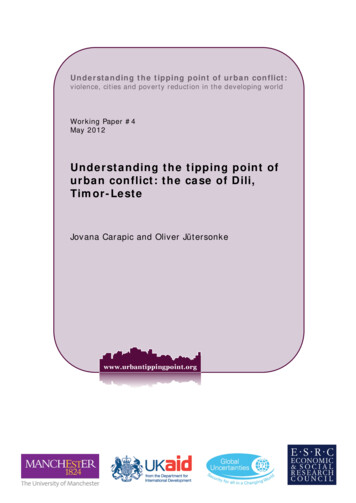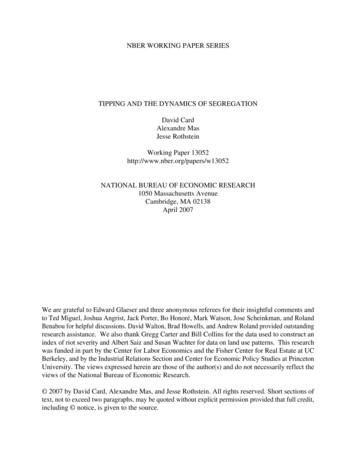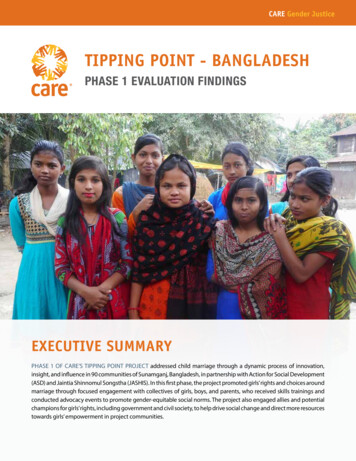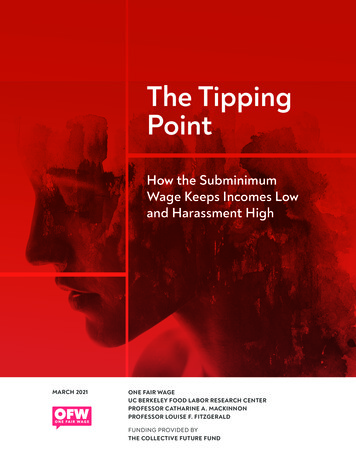
Transcription
The TippingPointHow the SubminimumWage Keeps Incomes Lowand Harassment HighMARCH 2021ONE FAIR WAGEUC BERKELEY FOOD LABOR RESEARCH CENTERPROFESSOR CATHARINE A. MACKINNONPROFESSOR LOUISE F. FITZGERALDFUNDING PROVIDED BYTHE COLLECTIVE FUTURE FUND
THE TIPPING POINT:HOW THE SUBMINIMUM WAGE KEEPSINCOMES LOW AND HARASSMENT HIGHAs one of the largest employers of women,1 one of the largest employers of youngpeople,2 and one of the largest private sector employers,3 the restaurant industry plays an outsized role in shaping both the early formative work experiencesof young women and men and the ongoing experiences of the millions whocontinue to work in it. The high levels of sexual harassment in this industry have beenfound by numerous studies. This report documents the findings of the first nationallyrepresentative sample to establish the prevalence of sexual harassment among tippedworkers, its connection to tipped workers’ subminimum wage, andthe consequences faced by survivors, including retaliation by employers for reporting. This harassment has become more severe andlife-threatening for tipped workers during the COVID-19 pandemic.4 The research is particularly timely in informing discussions overlegislation now being considered in Congress to phase out the subminimum wage for tipped workers.KEY FINDINGSThe nationally representative survey, conducted by Social ScienceResearch Solutions (SRSS) in January 2021, produced the followingresults:1 O verall, 71% of women restaurant workers had been sexually harassed at least onceduring their time in the restaurant industry. This percentage is the highest of anyindustry reporting statistics on sexual harassment. Indeed, it dwarfs any other.2 W hile women restaurant workers are most frequently harassed by customers, theyare also pervasively sexualized and sexually harassed by supervisors, managers, orrestaurant owners. Combining tipped and non-tipped workers, 44% stated they hadbeen victims of sexual harassment from someone in a management or ownership role.3 T ipped workers who receive a subminimum wage — this occurs in 4 out of 5 states— experience sexual harassment at a rate far higher than their non-tipped counterparts. Tipped workers were significantly more likely to have been sexually harassed2
than their non-tipped counterparts: over three quarters versus over half (76% vs. 52%).This finding corroborates earlier studies that showed that workers in states with a subminimum wage of 2.13 report double the rate of rate of sexual harassment comparedwith workers in states with no subminimum wage for tipped workers.54 T ipped workers were sexually harassed significantly more frequently, in every waymeasured, than their non-tipped counterparts. Tipped workers were more likely tobe treated in sexist ways; more likely to be targeted with sexually aggressive and degrading behavior; received more persistent and intrusive sexual attention, were more likelyto be coerced or threatened into sexual activity they did not want and were more likelyto be victims of sexual assault than their non-tipped counterparts. These differencesbetween tipped and non-tipped women workers’ experiences were not only statisticallysignificant but substantial.5 T hese experiences represented not one-time harassment, but often persisted overdays, weeks, and in some cases, months. Thirty seven percent of the workers interviewed described situations in which the harassment continued for a month or more,and that the behaviors during this period occurred frequently or almost every shift (35%).6 W hen workers reported the sexual harassment, tipped workers were less likelyto say that the situation was corrected than their non-tipped counterparts (61% to73%). Tipped workers were substantially more likely than their non-tipped counterparts to say that they had been encouraged to “just forget about it” (39% to 23%).7 V irtually all (98%) of the harassed women workers reported experiencing at leastone incident of retaliation when all forms of retaliation were taken into account;tipped workers experienced significantly and substantially more retaliation thantheir non-tipped counterparts. There were almost no differences reported betweentipped and non-tipped workers as to the particular form the retaliation took, with theexception that tipped workers were more likely to say they had been threatened by theiremployer for reporting sexual harassment; none of the non-tipped workers reportedthis experience.3
1. INTRODUCTIONCOVID-19’s devastating impact on the service sector has been well documented,including the closure of thousands of restaurants and the unemployment ofmillions of food service workers nationwide.6 These impacts fall especially hardon women who are tipped workers. A legacy of slavery, the federal subminimumwage for tipped workers is still 2.13 an hour; 43 states persist with a subminimum wage insome form, forcing a workforce that is 65% women to rely heavily on tips to supplementtheir wages to support themselves and their families.7 Tipped workers across the countryare disproportionately people of color and women,8 who suffer from nearly three timesthe poverty rate of the rest of the U.S. workforce and use food stamps at double the rate ofthe rest of the U.S. workforce.9Since the COVID-19 pandemic, these workers have experienced massive declines in overalltips due to enforcing pandemic safety measures, while facing higher rates of exposure anddeath due to the virus. The same workers report higher rates of sexual harassment fromcustomers demanding they remove their masks to judge whether they deserve tips.10In 2021, Congress is considering the Raise the Wage Act, which proposes to raise the overall minimum wage to 15 an hour and phase outthe subminimum wage for tipped workers, workers with disabilities,and youth.11 This bill would have a significant impact on the lives ofmany workers, especially women in the food service sector, who evenprior to COVID had some of the lowest wages in the country compared with their male counterparts.12 Research to further understandand document the relationship between the subminimum wage fortipped workers, tipped work, and sexual harassment is thus criticalin this current debate.Previous studies have shown the correlation between the subminimum wage and sexual harassment. In 2014, the RestaurantOpportunities Centers (ROC) United and Forward Together conducted a survey of 688 restaurant workers nationwide. It found thatworkers in states with a subminimum wage of 2.13 an hour were twice as likely to reportexperiencing sexual harassment as workers in the 7 states with a full minimum wage fortipped workers with tips on top, and three times as likely to report that their employer encouraged them to wear more provocative clothing (making them vulnerable to increasedharassment) in order to earn more money in tips.13 The study demonstrated that the subminimum wage for tipped workers, which increases dependence on customer tips, forces4
a workforce of mostly women to tolerate abusive customer behavior in order to surviveeconomically and feed their families.Since COVID-19, this power dynamic between tipped workers and customers has beenexacerbated. In December 2020, our team published a study based on more than 1600surveys of tipped workers collected in fall 2020. More than 40% of food service workerssurveyed reported that they had noticed a change in the levels of unwanted sexualizedcomments from customers. Hundreds of women shared comments they received frommale customers demanding they take off their masks so that they could calibrate their tipsto their looks and willingness to expose them on demand.14 These findings demonstratedthat the subminimum wage for tipped workers and forcing a workforce of mostly womento feed their families on tips subject to customers’ sexualized discretion, extended froman issue of racial, economic, and gender inequality to a threat to life.Building on these previous findings, the present study examines in further depth the sexualharassment of women in the restaurant industry and consequences, such as retaliation,for reporting it. No other study to date has surveyed a nationally representative sample toilluminate this experience both in depth and over the working time periods of those whoserve in the restaurant industry. The report focuses on the nature and characteristicsof the sexual harassment experienced by women who are tipped workers in restaurantsacross the country.5
2. METHODOLOGY AND SAMPLEThis report summarizes the findings of the first ever nationally representative sample of women aged 31 and older who worked in the restaurant industry, 75% ofwhom rely on tips for the majority of their wage.Working with SSRS, a large social science research consulting firm, employedwomen aged 31 and older were invited by email to participate, then screened to ensure theywere currently employed and had previously worked in the restaurant industry. To providerepresentative non-biased results that corresponded to the target population, standardweighting techniques matched the sample’s reported demographic characteristics withthose of employed women aged 31 and over.Of the 510 current and former women restaurant workersin the research sample, 406 worked in tipped positions, 104were non-tipped. Food service is the most common first jobfor America’s women.15 Not surprisingly, more than 75% ofthe sample were between 15 and 21 years old when they began working in the restaurant industry. Sixty-three percentof the participants identified as white, 13% as Black or AfricanAmerican, 17% as Latinx or Hispanic. Seven percent identifiedas mixed race or with another racial or ethnic background.A widely-used validated survey instrument for investigatingand measuring sexual harassment experiences in employment was adapted and modified based on previous researchby ROC to examine the nature, character, and extent of sexualharassment by restaurant workers and its long-term effectson them. The perpetrators — customers, employers, and/orco-workers — were identified; the frequency and duration of sexual harassment was documented; the impact of particular experiences was focused; the consequences, includingretaliation, of reporting sexual harassment to employers were investigated. Workers wereasked to recall and describe the one event that had left the greatest impression on them.Participants were asked to rate each of these factors, experiences, and responses, and toprovide open-ended responses to some. The instrument was self-administered online,with quality checks to ensure attention. Follow-up interviews were conducted with someconsenting participants by One Fair Wage staff to provide further depth, detail, and voiceto the findings.6
3. THE SEXUAL HARASSMENT EXPERIENCEDBY RESTAURANT WORKERSNATURE AND TYPES OF SEXUAL HARASSMENTOverall, 71% of women restaurant workers had been harassed at least once during theirtime in the industry. This percentage is the highest of any industry reporting statistics onsexual harassment, bearing out the findings of the 2014 study conducted by ROC Unitedand Forward Together. As in that previous study, tipped workers were significantly morelikely to have been harassed than their non-tipped counterparts – over three quartersversus over half (76% vs. 52%). Tipped workers were also harassed significantly more frequently in every way measured. Tipped workers were more likely to be treated in sexistways; more likely to be targeted with sexually aggressive and degrading behavior; receivedmore persistent and intrusive sexual attention, were more likely to be coerced or threatened into sexual activity they did not want, and more likely to be victims of sexual assault.These differences between tipped and non-tipped women workers were not only statistically significant but substantial. Tipping explains vastly more of the variance in these datathan any other single factor.Table 2 outlines these differences for each type of sexually harassing behavior. Table 3summarizes these experiences.TABLE 1PREVALENCE OF SEXUAL HARASSMENTAMONG WOMEN RESTAURANT WORKERSTABLE 2 CONTINUED ON FOLLOWING PAGEDEGREE AND NATURE OF SEXUAL HARASSMENTAMONG WOMEN RESTAURANT WORKERSReport at least one harassment experienceSexist Behavior71%All Workers59%All Workers76%Tipped Workers64%Tipped Workers52%Non-Tipped Workers40%Non-Tipped WorkersSource: SRSS nationally representative sample of 510 womenwho worked in the restaurant industry, January 20211. Referred to women in insulting or denigrating terms5. M ade sexist or demeaning remarks (e.g., suggestingwomen can’t/shouldn’t do certain kinds of jobs8. Treated you badly or less favorably because you’rea womanSource: SRSS nationally representative sample of 510 women who worked in therestaurant industry, January 20217
TABLE 2 CONTINUED FROM PREVIOUS PAGEDEGREE AND NATURE OF SEXUAL HARASSMENT AMONG WOMEN RESTAURANT WORKERSSexually Hostile BehaviorSexual Coercion59%All Workers33%All Workers63%Tipped Workers39%Tipped Workers41%Non-Tipped Workers14%Non-Tipped Workers2. Told sexual stories or jokes that were offensive ordemeaning to you.15. Offered or implied some sort of reward or specialtreatment to engage in sexual behavior3. Name calling based on dress, sexual activity,promiscuity, sexual orientation or preference16. Threatened some sort of retaliation if you weren’tsexually cooperative (e.g., shift change)6. M ade offensive or denigrating remarks about yourappearance, body or sexual activities17. Treated you badly because you wouldn’t do what theywanted sexually9. M ade crude gestures or used body language of asexual nature.12. Told you to alter your appearance beyond the dresscode (e.g., “be sexy”, wear tight clothing11. S ent or showed you texts, messages, or picturesof a sexual or denigrating nature13. Asked/told you to flirt with guestsSexually Assaultive BehaviorIntrusive Sexual Attention54%All Workers59%Tipped Workers36%Non-Tipped Workers4. K ept asking you out (e.g., dates, drinks, dinner) eventhough you said “No”?17%All Workers20%Tipped Workers7%Non-Tipped Workers14. Exposed sexual or intimate parts of their body to you(e.g., penis)7. Touched you in a way that made you uncomfortable?18. Attempted to have sex with you that you did not wantbut was not successful10. Attempted to stroke, fondle, grope, kiss, or grab you?19.Had sex with you that you did not wantTABLE 3SUMMARY OF TYPESOF HARASSMENTEXPERIENCED BYRESTAURANT WORKERSFigures sum to than 100%because workers reportedexperiencing more than onetype of behaviorAll WorkersTipped WorkersNon-Tipped WorkersSexist Behavior59%64%40%Sexually Hostile Behavior59%63%41%Intrusive Sexual Attention54%59%36%Sexual Coercion33%39%14%Sexually Assaultive Behavior17%20%7%Source: SRSS nationally representative sample of 510 women who worked in the restaurant industry, January 20218
WORKER PROFILEShelly Ortiz“I was 15 years old ”Shelly Ortiz started in the food industry when she was 15 years old;she was 25 when she finally left. She had worked as a barista,bartender, and server at different restaurants in Phoenix,Arizona while pursuing her work in documentary filmmaking. Although filmmaking was her dream, her restaurantwork provided one huge advantage: compared to the sporadic nature of her film jobs, “[T]he restaurant industry hadalways provided consistency in income.” This consistencycame at a price however, as she recalls being harassed regularly in virtually every restaurant she worked and everyposition she held; it only got worse with the pandemic.“I had men [in] the line tell me if I was a feminist, then theycould punch me”As a young, gay Puerto Rican woman, she always had tostand her ground or prove her worth to her coworkers, managers, and customers. “I am very short in stature, so I’m justthis short Puerto Rican girl, I always had a lot of obstaclesagainst me to prove I was hardworking.” As a feminist, Shellysays she was often faced with men who saw her convictionfor women’s rights as a justification for violence. “When I wasyounger, I had men [in] the line tell me if I was a feminist thenthey could punch me.”Sexism and misogyny permeated every part of her workinglife. Shelly says that she could not recall a time when shewas not treated differently, and worse, because she was awoman. Despite the regular occurrence of these incidents,whether sexualized remarks or being “hit on” by coworkersand customers, Shelly was still shocked this summer by thecomments of a customer.“[Because I wouldn’t take off my mask for him], he said he had to stare at my tits”On a busy summer Saturday night after the onset of thecoronavirus pandemic, Shelly was serving an older man andhis wife. After dropping off the check, the man told her topull down her mask. “He said he wanted to see if the bottomhalf of my face was as cute as the top half, and I said no.Then he said because of that, he had to stare at my tits.”Shocked, Shelly looked to the man’s wife in disbelief, seeking some sort of shared embarrassment or comfort, butsaw nothing. She asked her manager to handle the checkfor her. But Shelly says she felt almost irresponsible, in thatshe put her own feelings of safety and comfort above the“customer experience,” feeling guilty she did not close thetab on her own as usual.The whole ordeal left her feeling disposable and sexuallycommodified, a feeling she said was not new, especiallyafter the pandemic began and restaurant work becamemore competitive. “You feel really disposable as an industry worker, especially as a woman, to be made to feel likeyour physical presence is a factor in getting money.” Whenshe talked to her coworkers about it, she found sympathyand camaraderie in that most everyone said they regularlyexperienced such comments. She feels the pervasivenessof behavior like this desensitizes tipped workers, loweringtheir expectations and even standards for how they will betreated. After her initial feelings, Shelly says the entire evening felt “so normal.”“No one should have to tolerate threats to their safety inorder to put food on their table.”Since leaving the food industry, Shelly says she has begunto heal. “Since I have left the food industry my self-worthhas come up so much. I had to reprogram my brain.” Hertime away has allowed her to reflect more on her decade asa tipped worker, and the impact that relying on tips has onjob security, safety, and integrity.“[Tipping] does put a lot of value in performative working No one should have to tolerate threats to their safety inorder to put food on their table.” At restaurants, she often heard guests complaining that a server failed to smileenough or was not energetic. “If you are not a perfect server then you are not going to make a living wage.” She feelsnow that she is out of the industry, she has a responsibilityto speak out about these experiences. “I can speak and notface repercussions with my employer.” Shelly hopes to seea living wage implemented to free restaurant workers fromtolerating inappropriate, rude, and threatening behaviorfrom others. “I wish there was less pressure on women andqueer people to be able to just do a job well and not haveto tolerate horrible and destructive behavior.”9
A CLOSER LOOKBecause sexual harassment is so widespread in the restaurant industry, and women workers typically are employed by various establishments over time, in multiple types of jobsover the course of their career in food service, summary numbers such as those reportedabove collapse many incidents, restaurants, and harassers in a food service worker’s life.To get a deeper sense of the reality of their experience, our participants were asked to tellus about the one experience that had the greatest effect on them. This offered a closer lookat what happened to the participants, who did what, how they felt, what they did about it,and what happened as a result.Some of the women surveyed detailed sexist norms they had to endure while working inthe restaurant industry such as being expected to “smile” through inappropriate behaviorand not to expect any change in these behaviors from male customers and colleagues:“I think the most common one is the ‘be pretty and smile.’ Every time I’m in a situationwhere I’m interacting with customers, there’s always at least one sexist older man whothinks it’s ok to say that. They act as if because I’m working I’m forced to flirt with them.My male coworkers are never told anything like that.”“A supervisor made sexual advances towards me and when I complained I was told‘You know that’s how he is.’”Other women reported sexually defamatory rumors, intrusive sexual attention, and sexualassault, in some instances from coworkers as well as customers:“My boss made comments about having sex with me to my coworkers even though it didnot happen. Additionally, my boss also would stare at me and make sexual commentsabout my appearance.“We all usually hung out after work and his friends that didn’t work at [the] restaurantand they mistreated me and one of them raped me while I was sleeping at somebody’shouse one night!”“I had a much older coworker, who was technically a superior, smack my butt as Iwalked by him.”“[T]here was a supervising manager that was constantly making sexuallyinappropriate comments and jokes that were very dirty and made me veryuncomfortable, especially because he would call me out or hit on me after.”“When my supervisor forced me to let him go down on me.”10
“Coworker telling me about his sex life and asking me about mine. Often and gettingway close to me smelling my hair etc.”“Coworker harassing me and stalking me.”“That one customer tried rape and use my weakness.”Notably, for the most part, these experiences involved many kinds of harassing behaviorand continued at times for weeks or months. Unlike a common stereotype that sexualharassment is a single brief event, this shows that in reality it can be an ongoing processthat lasts for a considerable period of time, particularly for women who are harassed bycoworkers, supervisors, or managers. In the present research, 37% of the sample reportedthat the situation reported here continued for a month or more, and that the behaviors inthis episode occurred frequently or almost every shift(35%). Fifty-three percent of non-tipped workers and43% of tipped workers reported that they were between16 and 21 years of age when this experience of sexualharassment happened — formative years in these women’s lifelong work experience.When asked to tell about the experience of sexual harassment that had the most effect on them, participantsdescribed being subjected to a wide range of behaviors from sexist and sexually hostile remarks (11%) toegregious encounters that included coercion and/orsexual assault (36%). Approximately 27% reported experiencing a single type of harassing behavior only; 14%reported that their experience included every form ofsexual harassment measured by the survey; another12 % reported experiencing every form of harassmentexcept sexual assault; 12% described sexist and sexually hostile remarks along with someform of intrusive sexual attention; 11% reported sexist and sexually hostile remarks alone.Some experiences were brief — 27% said this most affecting experience happened only onetime — but most were not; 37% said the experience lasted a month or more. Some workerswere in their 30’s and beyond at this time, but fully 75% of the tipped workers were under24 years old when this happened to them. In the sections below, these experiences are unpacked to examine who committed them, how the victims responded, and — particularly— the impact of tipping on the experience of harassment and its aftermath.11
WORKER PROFILELori GainesIn 2017, Lori Gaines* at age 25 entered the restaurant industry, working as a bartender in New York City. Having workedoutside food service up to that point, Lori was unpreparedfor the amount of sexism and harassment she faced at hernew job. She quickly learned that she would receive littlerespect from guests in ways that were directly tied to beinga woman.“I used to have plenty of customers come in and makecomments they never would have said to men, calling mehoney or sweetie.”Initially, Lori was scared to speak up. As it was her first timeworking in a restaurant, she did not want to risk angering customers by speaking up, since she was dependenton their tips that made up a substantial part of her wage.She felt it better to brush off these comments. But as timewent on, she became aggravated at the constant stream ofdisrespect in almost every interaction. She started tellingcustomers: “If you want to be served by me you have totreat me with respect, like you would speak to a male.”These irritations were bad enough, but minor comparedwith the unwanted attention, including sexual harassment,she experienced on her late-night shifts. As a bartender,Lori often dealt with overly intoxicated customers. Whilemany men were annoying and some were dangerous, oneman in particular came to her mind when recounting herexperience working these shifts.“I can think of one particular person who would come in,and he would be fine in the beginning. But then he wouldget really drunk, he would start calling me names andsay we should go out, and [he would] get progressivelydrunker, and try to go behind the bar.”Frustrated with this customer’s behavior, Lori brainstormedseveral solutions and presented them to her bosses. “I triedmultiple times to get the owners to ask certain people notto come, or put a drink limit, but nothing came from that.”By the time she began to regularly deal with sexual harassment from that particular customer, she was luckily alwaysworking alongside another staff member. Previously, shehad to work closing shifts until four in the morning by herself. After several of these shifts, she quickly let her bossesknow she was completely uncomfortable with being alone.“I would never feel comfortable working by myself it’s uncomfortable, especially if they’re drinking. You never knowwhat they will say or if they would try to act on something.”Lori feels her reliance on tips exacerbated these issues. Sheneeded a steady income, and tips were a large part of that.In the beginning, she said she felt pressure to simply dealwith the unwanted comments, even sexual proposals fromguests.“I had people sit there and tell me they would pay memoney for me to lean over them and kiss them.”After a while, she could no longer stand to be subjectedto that kind of behavior. “Of course, if you just stand thereand smile and accept things, they feel happy and they tipyou more. If you say something back, they won’t tip or willleave a tiny tip. That didn’t matter at that point, it’s betterto stick up for yourself.” Often, when she stood up for herboundaries and demanded respect from customers, theytipped her less. She paid for her dignity herself.“I don’t think I would’ve lasted too long.”Eventually, in 2019, Lori left bartending and the restaurantindustry behind. She now works in an office. Although thereis sexism in the world, she says, it is not nearly as frequentor severe in her current position. “[Sexism] exists obviouslyat any other job, but it’s nothing compared to what it was inthe restaurant.” The managers and owners of her restaurantcared little about her comfort or safety and failed to safeguard her during the years she worked there. “If I told themanything, they wouldn’t really care too much.” Lori is happyto be out of food service and away from the need to subjectherself to unwanted behavior that is normally consideredunacceptable in order to make a living.*A pseudonym is used to protect the worker.12
4. PERPETRATORS OFSEXUAL HARASSMENTWHO ARE THE SEXUAL HARASSERS?When restaurant workers were asked to identify who harassed them, forty-eight percentof the tipped workers reported that they were harassed by customers (28% by only customers), while only 26% percent of non-tipped workers were harassed by customers at all. Thisis not surprising given that tipped workers, especially if they are paid a subminimum wageby their employer, are dependent on customers for tips, and must tolerate customer behavior to obtain those tips. Conversely, the non-tipped workers were more likely to be harassedby supervisors/managers/owners (48%) and 37% were harassed by only supervisors/managers/owners. Although the overall percentage of sexual harassment by coworkers did notvary with respect to tipped status, non-tipped workers were considerably more likely to beharassed by only their coworkers.TABLE 5WHO WAS THESEXUAL HARASSERAll WorkersTipped WorkersNon-Tipped WorkersSupervisor, Manager, or Supervisor, Manager, or Owner only25%22%37%Coworkers only23%22%30%Customers only27%28%20%REACTION TO THE SEXUAL HARASSERTABLE 6REACTION TO THE SEXUAL %disturbing31%traumatic56%degradingResearch has shown that virtually all targets experienced negativeemotions in response to being sexually harassed. In the presentstudy, the great majority of the participants found their experienceto be very or extremely annoying (71%), inappropriate, (70%), demeaning (63%), and/or disturbing; more than half of them felt upset,embarrassed or degraded; almost 40% felt very or extremely threatened, and approximately one-third felt very or extremely frightened,and found the experience very or extremely traumatic. Tipping status had little effect on the more intense reactions (i.e., threatening,frightening, traumatic); however, tipped workers were more likely tofind their experiences to be very or extremely disrespectful, annoying, demeaning, disturbing, embarrassing, degrading, and upsetting.13
5. CONSEQUENCES OF REPORTINGTHEIR SEXUAL
The Tipping Point How the Subminimum Wage Keeps Incomes Low and Harassment High . 2 A s one of the largest employers of women, 1 one of the largest employers of young people,2 and one of the largest private sector employers, 3 the restaurant indus - try plays an outsized role in shaping both the early formative work experiences

